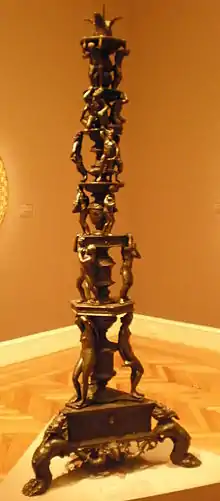Altar candlestick
Altar candlesticks hold the candles used in the Catholic liturgical celebration of Mass.

An Italian bronze altar candlestick from Padua, ca. 1550, by the workshop of Severo Calzetta da Ravenna.
Structure
These candlesticks consist of five principal parts: the foot, the stem, the knob, the bowl to catch drippings, and the pricket on which the candle is placed.[1]
History
Before the 10th century AD, altar candlesticks were not used. They were used occasionally by the thirteenth century, and in the sixteenth, they were in common use.
Regulation
Altar candlesticks may be made of any material suitable for candlesticks, with the exception that silvered candlesticks may not be used on Good Friday.[1] They may never be used for funeral celebrations.[1] Also, they may not be covered by cloth or lace, and candelabra are prohibited, so each candlestick must be distinct.
References
- Schulte, Augustin Joseph (1907). . In Herbermann, Charles (ed.). Catholic Encyclopedia. 1. New York: Robert Appleton Company.
This article is issued from Wikipedia. The text is licensed under Creative Commons - Attribution - Sharealike. Additional terms may apply for the media files.